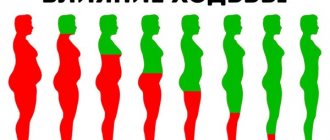Why is obesity dangerous?
First of all, because obesity is the basis for the development of many diseases. These are diabetes mellitus, atherosclerosis, lipid (fat) metabolism disorders. The complex of changes that occurs in the body of a person suffering from excess weight leads to the development of hypertension, atherosclerosis and coronary heart disease.
In addition, obesity can cause gynecological problems. The female reproductive system is very sensitive to the influence of hormones secreted by adipose tissue. Against the background of obesity (especially abdominal obesity, when the main reserves are concentrated in the abdominal area), a disorder of carbohydrate metabolism such as insulin resistance . Insulin resistance is the body's insensitivity to the action of its own insulin, which is responsible for glucose metabolism. Insulin resistance is the cause of the development of polycystic ovary syndrome . And for a woman this means irregular menstrual cycles, acne, hirsutism and even infertility. In older women, menopausal metabolic syndrome , which includes carbohydrate metabolism disorders including diabetes mellitus, hypertension, coronary heart disease and lipid metabolism disorders.
Excess weight is also dangerous for a pregnant woman. Such a pregnancy, as a rule, occurs with complications for both the mother and the unborn child. Obese pregnant women are more likely to experience miscarriage, the development of gestational diabetes mellitus, preeclampsia, infections of the genitourinary system and complications during childbirth. The child has a significantly increased risk of developing congenital malformations. For example, if the body weight before pregnancy exceeded 80 kg , then the risk of neural tube defects in the fetus increases 2 times, and if a woman weighed more than 110 kg , then 4 times.
Fetal macrosomia, intrauterine growth retardation, and an increased incidence of birth trauma in newborns are all complications characteristic of obese pregnant women.
What leads to weight gain
Every 10 years, energy costs are reduced by 10%. We ourselves don’t notice how our body takes on a rounded shape, and then we diligently lose weight - we go on diets, limit ourselves in everything, even starve, in order to fit into our favorite jeans, get rid of the load on our internal organs, and avoid diseases. All to no avail - only two things are truly effective: proper nutrition and proper attitude.
But to start the fight against extra pounds, you need to understand what led to the problem. There are many reasons:
Prolonged stress
Everyone relieves nervous tension differently. Some people dance, some watch melodramas, some eat too much. Confectionery and fast food most often act as antidepressants. It is not surprising that on such “medicines” for melancholy and sadness, we gain weight day after day.
Taking medications
If you regularly use antibiotics, oral contraceptives, steroids or hormonal drugs, you have a good chance of gaining weight. These drugs directly or indirectly affect the condition of our figure. The way out of the situation is to contact your doctor with a request to reduce the dosage, stop self-medication and self-prescription of medications that can cause obesity or lead to other adverse consequences.
Improper and irregular nutrition
Do you eat when you have to and always take an extra portion? Do you prefer fast food, sweets, semi-finished products, fatty, fried and flour-based foods? Then you risk not only gaining weight, but also developing diabetes, early atherosclerosis and other equally dangerous diseases that go hand in hand with being overweight.
Lack of proper sleep
Researchers have proven that a person who does not get enough sleep every night for a week lives with elevated insulin levels. As a result, a special condition develops: decreased sensitivity to the action of insulin, which leads to diabetes. Intermittent or short sleep leads to a shortening of the fat breakdown phase and a slowdown in metabolism. So by choosing a night vigil instead of a full night's sleep, you are harming yourself and your figure.
And these are not all the reasons: the list of factors influencing our weight includes fluctuations in the menstrual cycle, food allergies, and insufficient fluid intake.
But before you go to a specialist and change your diet, you need to determine whether we need to lose weight. Many people go on diets even with a body weight that is completely normal for their own body composition, because they strive to be like supermodels from glossy magazines and do not want to feel like a “plump” among “skinny” women. This desire is dangerous due to exhaustion and the acquisition of new health problems.
How to determine if you are overweight?
There is a fairly simple formula that is used by doctors all over the world. This is the body mass index (BMI). The index is calculated in three stages.
- Measure your height in meters and square that number.
- Measure your weight in kilograms.
- Divide your weight (in kilograms) by the square of your height (in meters)
Example: Your height is 1.68 m . m2 = 1.681.68 = 2.82.
Example: Your weight is 62 kg .
Example: 21.9 kg/m2
Normal BMI values are those that fall within the range from 18.5 to 24.9. A BMI from 25 to 29.9 is considered overweight, and a BMI greater than 30 is considered obese.
In addition to BMI, the most important indicator for health is waist circumference . Waist circumference is measured with a measuring tape midway between the bottom edge of the ribs and the top edge of the pelvic bone (as shown in the picture). The measuring tape should lie strictly horizontally and should not cut into the skin. Waist circumference allows you to judge the deposits of internal, abdominal fat.
Abdominal circumference in women greater than 80 cm , and in men greater than 94 cm is a risk factor for the development of diabetes mellitus, lipid metabolism disorders, and hypertension. In addition, it is a marker of insulin resistance , which may cause the development of polycystic ovary syndrome and associated infertility and cycle disorders.
Guessing by wrist
This method is also elementary, but unfortunately, even less accurate than the experiment with waist size. Still, if you are worried about how to quickly find out your weight without a scale, then your wrist and height will help you. By the way, you don’t even need a measuring tape here, which makes this calculation option even more convenient.
So, grab your wrist so that your thumb and index finger are loosely connected. If this trick was successful without difficulty, then you are one of the asthenics - people with a slender physique. In this case, the formula for calculation is as follows: (height - 100) - (height x 0.1) = your approximate weight.
For example, you were able to connect your fingers on your wrist, and your height is 168 centimeters. We count: (168 – 100)—(168 x 0.1)=51.2 kilograms. But this formula only works for this body type and only if there are no visible problems with excess weight.
People who cannot clasp their wrist freely need to calculate their weight a little differently: (height - 100) + (height x 0.1) = your approximate weight. In an example, it looks like this: (168 – 100) + (168 x 0.1) = 84.8 kilograms. As you can see, the difference is noticeable, so it is important to approach the wrist measurement honestly and remember that the finger ring should be loose.
How to change your lifestyle?
Unfortunately, there is no miracle method for losing excess weight. Surgeries and drug therapy are all just assistants on the path to weight loss that have a temporary effect. Obesity occurs due to consuming more calories than the body needs, and therefore the only treatment is to change this situation.
Lifestyle changes are based on two pillars: eating a sensible diet and increasing physical activity. Don’t try to start a new life “on Monday” - move towards your goal gradually, achieving new results every day.
Think and write what goals you need to achieve. Don't try to immediately lose weight to your ideal weight. At the first stage, try to reduce your weight by 5-10% of the original, remember that rapid weight loss is no less dangerous to health than obesity.
Nutrition.
Some tips to help you cope with obesity.
- Try to eat more often. Yes, it sounds ambiguous, but the most favorable diet for the body is one that includes 3 main meals (breakfast, lunch, dinner) and two additional ones. Remember that your last meal should be at least 2 hours before bedtime. Nutritionists recommend consuming at least 1200 kcal per day. If you are used to eating more, reduce your daily caloric intake gradually.
- Eat slowly and enjoy your food. The saturation signal takes about 15 minutes to reach the brain. The slower you eat, the less you will eat, because the signal of fullness will have time to arrive in time.
- Drink enough water. The average fluid intake is eight glasses per day. Avoid sweet, carbonated drinks and soft drinks. Choose water with lemon, tea or coffee without sugar.
- Your diet should contain approximately 30% fat, 55 - 60% carbohydrates and 15% protein. Be sure to eat green vegetables and fruits every day. Eating vegetables as a snack before the main course will help reduce the number of calories you eat.
- Watch the calorie content of your foods. Please see the label for complete nutritional information. Try to eat as little food as possible that is high in fat and calories, that is, limit the amount of the following foods.
Products containing a lot of fat (including hidden fat).
- Vegetable, ghee and butter, margarine, mayonnaise.
- Sauces and gravies.
- Nuts, sunflower seeds, olives.
- Fatty fish and meat.
- Smoked products, canned food (especially in oil).
- Cream, sour cream, fatty varieties of cottage cheese and cheese (with a fat content of more than 30%, including processed cheeses, sweet cheeses, curd masses).
- Sausages.
Foods containing easily digestible carbohydrates (that is, containing many calories).
- Sugar and sugar-containing products: chocolates, pastries, cakes, creams, ice cream (also containing a lot of fat).
- Dried fruits
- Grapes, bananas
- Choose foods rich in starch and fiber . These products include:
- Bread and cereal products containing bran or made from whole grains
- Durum wheat pasta
- Grains
- Fruits and vegetables
- When cooking, give preference to the grill, microwave or barbecue, do not add fat or oil. Use non-stick cookware and cook in foil. Trim visible fat from meat, and do not eat the skin of poultry or fish.
- Try to limit the amount of alcohol. Alcohol increases appetite, and, in addition, a lot of fatty and salty foods are eaten with alcohol.
- Keep a food diary. Regardless of whether you work with a doctor or try to monitor your weight yourself, a food diary will help you assess the quantity and quality of what you eat per day. Write down everything you eat and at the time you eat it, even if it's candy you grabbed on the run. In addition, note your weight and physical activity there.
- Think about it: do you always eat because you are hungry? Or do you eat away at troubles, anxiety and sadness? Or are you just having a snack for company? Try not to eat while watching TV.
- What to choose if you come to a restaurant?
- First, before going to a restaurant or visiting, have a light snack. Don't leave the house feeling hungry.
- Order grilled, stewed, baked, boiled or barbecued dishes.
- Avoid eating fried foods, crunchy foods, creamy or creamy sauces, cheese or cheese sauces. If you are not sure how a dish is prepared, ask the waiter. Please ask that the sauces be served separately. Give preference to boiled, stewed or grilled vegetables. To reduce portion size, you can order 2 types of appetizers instead of the main course. Take one dessert for two.
- Ask for skim milk in your coffee. Choose low-calorie drinks: water, tomato juice, soda, drinks with sugar substitutes, low-calorie beer.
- Take your time to eat the whole portion, eat slowly, enjoy your food.
- Try to think through your diet in advance. When creating a menu, use the food pyramid.
| Food group | Number of servings per day | Serving Size |
| Lean meat, poultry, fish and shellfish | 170 g or less | — |
| products made from low-fat milk (up to 2.5% fat content) | 2-3 | 1 cup milk 1 cup yogurt 28 g low-fat or low-fat cheese |
| Eggs | 4 yolks per week | — |
| Fats and oils (including salad dressings and nuts) | 6-8 | 1 tsp margarine or vegetable oil 1 tbsp. salad dressing 28 g nuts |
| Fruits | 2-4 | Whole fruit ½ cup chopped fruit ¾ cup fruit juice |
| Vegetables | 3-5 | 1 cup leafy or raw vegetables ½ cup cooked vegetables ¾ cup vegetable juice |
| Bread, cereals, rice, pasta, dry peas and beans, grains, potatoes | 6-11 | 1 slice of bread 28 g dry flakes ½ cup cooked group, dry peas or beans, potatoes, rice and other grains ½ cup tofu |
Body types
Physiologists distinguish three body types: ectomorphic (asthenic), mesomorphic (normosthenic) and endomorphic (hypersthenic).
Ectomorphs are people characterized by a thin build, narrow bones, long limbs and wiry muscles. Such people find it difficult to achieve in strength sports, since muscle development requires significant effort. Ectomorphs have a fast metabolism, their body burns calories very quickly, so it is more difficult for them to increase weight, in particular muscle mass, than for other types.
Mesomorphs are people with an athletic build and naturally developed muscles. It is not difficult for them to both gain and lose weight. Their muscles are well defined. Strength training gives quick results. However, fat accumulation occurs faster than in ectomorphs, so these people need to watch their calorie intake to stay in shape.
Endomorphs are people who tend to be overweight. If an enfomorph does not take care of himself, this will very quickly affect his appearance. Due to slow metabolism, fat accumulation occurs quickly. Mesomorphs have strong muscles, especially the thighs. They are often short in stature. The muscles are poorly drawn. It is more difficult for such people to lose weight than mesomorphs. When training, it is recommended to devote time to cardio exercises.
In reality, people who have a strictly defined body type are rare. Most people combine different types, for example, ectomorph-mesomorph and mesomorph-endomorph.
Is it possible to change your body type? Yes, with the help of a specially selected diet and training program suitable for your type. An endomorph is able to lose extra pounds and show others a good figure. An ectomorph can build muscle mass and demonstrate to others a strong, muscular body.
Physical activity
Dieting leads to weight loss. However, physical activity is indispensable in maintaining the achieved result. In addition, regular exercise helps reduce the risk of developing cardiovascular diseases. Start with light physical activity and gradually increase the intensity of your exercise.
For beginners, walking or swimming would be an ideal option. At the first stage, it is enough to exercise for 30 minutes 3 times a week. Gradually increase the training time to 45 minutes, and the number to 5 times a week. Replace an elevator ride with a stair climb, or one bus stop with a walk, and the number of calories burned will immediately increase. Exercise takes up your time, but it improves your well-being, protects your heart and brings pleasure.
Height to wrist ratio
The legs and arms are the first to react to quantitative changes. Their thickness and the ratio of muscle and fat components change. There are several body types, which can be determined by simply measuring the thickness of the wrist joint. For measurements, use a centimeter or woolen thread, which is then applied to a ruler to obtain a numerical value. In extreme cases, fingers - thumb and index - will do.
Body types:
- Length less than 16 cm or when gripping the index finger comes into contact with the thumb below the nail phalanx - asthenic.
- 16-18.5 cm, fingers closed easily - normosthenic.
- Over 18.5 cm, fingers stubbornly do not connect - hypersthenic.
Asthenics are thin, skin and bones. Normostenics need good physical activity and restrictions on high-calorie foods to stay in shape. Hypersthenics with wide bones are usually regular patients of the nutritionist.
How to find out your weight? You will need to measure your wrist and multiply the result by 4. This indicator will be the person’s weight.
An ordinary rope will provide interesting data. First, height is determined by it. Then they are folded in half and belted. If its ends come together without effort, and a fist fits freely between the stomach and the rope, the person has an ideal weight, the fist fits in with difficulty - everything is within normal limits. If the rope at the waist does not meet, it’s sad, there is excess.
Indexes and formulas
- 1) According to the Quettel index, the mass of asthenics is within 315 g for each cm of body length, for normosthenics this value is 360 g/cm, for hyperasthenics - 385 g/cm.
- 2) According to the formula of the French anthropologist Paul Broca, the approximate weight is calculated based on height and physique parameters. The accuracy of the calculation is related to the amount of body fat.
- 3) A certain part of people believe that it is possible to find out the amount of weight without resorting to instruments. The tools you will need are a tailor's centimeter. They act according to the algorithm:
- Measure your waist in cm.
- Write data.
- Subtract 5 from this value.
With a waist circumference of 85 cm, a person weighs 80 kg.
- 4) For the next technique you will need a children's swing such as a pendulum and several people in an equal weight category. Swing with each of them and determine who is heavier by the outweighing side.
- 5) Another option: on a swing, volunteers stand on the bar from opposite ends and begin to slowly approach the middle, towards each other. As soon as the board is balanced, stop. Then measure the distance from each person to the center of the board. Substitute the obtained values into the formula m1 = m2 x (l2/l1), where m1 is the mass of the volunteer, m2 is the mass of the friend, l2 is the distance to the center from the subject, l1 is the distance from the friend to the center, and calculate the person’s weight.
Waist and weight
One of the easiest ways is to refer to a measuring tape and your own waist. There is a formula that allows you to find out the approximate weight of a person. This is very simple to do: take a measurement of your waist 2 centimeters above the navel, and then simply subtract 5 from the resulting number and find out how many kilograms you are.
For example, your waist is 80 centimeters. According to the formula 80–5=75 kg. Of course, this indicator will not be absolutely accurate, but it is enough to determine the need for a diet.
How can you find out your weight without a scale? From physics to children's fun!
Every second girl in the world is dissatisfied with her appearance, and in most cases the main problem seems to be her figure. Needless to say, young ladies often simply exaggerate and turn a couple of extra pounds gained over the New Year holidays into a disaster. What's more, many of them don't realize that lavish dinners haven't actually impacted their waistlines! The easiest way to make sure of this is to weigh yourself. Well, what if there is no such possibility? How can you find out your weight without a scale?











